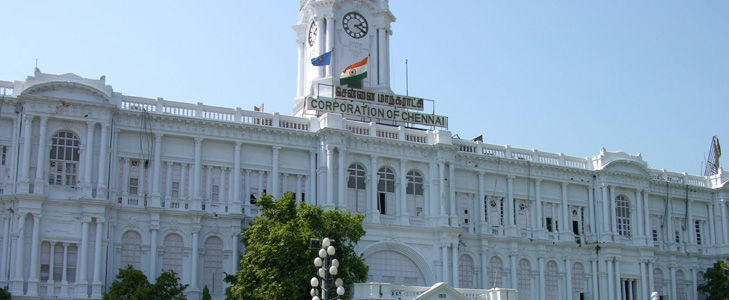Sights in Chennai

Fort St. George was the first British fortress in India, founded in 1639 at the coastal city of Madras, the modern city of Chennai. The construction of the Fort provided the impetus for further settlements and trading activity, in what was originally a no man's land. St. Mary’s Church, the oldest Anglican Church in India built in 1680 is located inside the fort. The tombstones in its courtyard are some of the oldest British tombstones in India. The weddings of Robert Clive and Governor Elihu Yale, who later founded the famous Yale University in the U.S.A, were officiated at St. Mary’s. The Fort Museum was completed in 1795 and first housed the office of the Madras Bank. The hall upstairs was the Public Exchange Hall and served as a place for public meetings, lottery draws and occasional entertainment. These relics are reminders of British rule in India. The museum’s collection features weapons, coins, medals, uniforms and other artifacts from England, Scotland, France and India dating back to the colonial period. Original letters written by Clive and Cornwallis make fascinating reading. One set of quaint period uniforms is displayed for viewing, as well. However, the most celebrated artifact is a large statue of Lord Cornwallis.
San Thome Cathedral Basilica gets its name from St. Thomas. Christian tradition holds that St. Thomas arrived in Kerala from Israel in 52 A.D. preached between 52 A.D. and 72 A.D., when he was martyred on St. Thomas Mount. The basilica is built over the site where he was believed originally to be interred. It was built in the 16th century by Portuguese explorers, and rebuilt again with the status of a cathedral by the British in 1893. The British version still stands today. It was designed in the Neo-Gothic style, favored by British architects in the late 19th century. Rising 155 feet from the ground, with a nave of 112 feet by 33 feet, and an imposing sanctuary 62 feet long and 33 feet wide, it is adorned with stained glass windows depicting St. Thomas and the other Apostles. Inside the sanctuary is a statue of St. Thomas seated. An ancient painting of Our Blessed Mother, in front of which the other great apostle of India, St. Francis Xavier, used to pray, is a notable work of art within the Basilica. The new underground chapel with a separate access outside the church structure, allows pilgrims to pray at the tomb and tourists to visit it, without disturbing the sacred functions in the church. The museum exhibits artefacts connected with St. Thomas and the Basilica, and the theatre is used for screening a short video on the life of the Apostle.
Vivekananda House, also known as Ice House, is a shrine and target of pilgrimage for the devotees of Swami Vivekananda. It is in this house that Swami Vivekananda stayed in 1897. During his nine day stay, he shook India’s national consciousness through his fiery lectures at Chennai. Built in 1842, the two-story house is a masterpiece of Victorian architecture with its characteristic designs of sunburst and gabled roof. The bedroom where Vivekananda stayed, lived and slept is now a safe haven for meditation. One can respectfully see the table at which he dined, placed downstairs near the fireplace. Devotees can stroll through the kitchen where he cooked his simple food, the parlor where he spoke and the garden where he frequently played with the children. These physical reminders of the life of Swami Vivekananda revive the great principles for which he stood all his life. Vivekananda House now houses a permanent exhibition on Indian culture and Swami Vivekananda’s life, as well as a meditation room, and is a source of inspiration to thousands of people who visit it every year.
The Government Museum Complex (also known as the Pantheon Complex) houses the Government Museum, Connemara Public Library and the National Art Gallery. Established in 1851, the museum consisting of six buildings and 46 galleries. On display you will find artifacts related to a number of disciplines including archeology, zoology, natural history, sculptures, palm-leaf manuscripts and Amravati paintings. Connemara Public Library is one of the four National Depository libraries which receive a copy of all books, newspapers and periodicals published in India. The Government Museum was established in the year 1857 and has the country’s best collection of South Indian bronzes, both ancient and modern, including beautiful bronze icons of Nataraja, Rama, Sita, Lakshmana and Hanuman. The sculptures were unearthed from the Buddhist ruins at Amaravathi and are housed here. Statues from the 10th and 13th centuries and handicrafts from the 11th and 12th centuries also are seen here. The National Arts Gallery was built in 1907. This magnificent red sandstone building was designed by Henry Irwin and built by T. Namberumal Chetty. The building represents a typical Indo-Saracenic structure and was initially famous as Victoria Memorial Hall. Built with sandstone and adorned with motifs, the building bears impressions of Mughal architecture. The gallery exhibits medieval handicrafts, sculptures, metal ware and paintings belonging to various schools of art. The museum is divided into four galleries: Tanjore Painting Gallery, Decorative Art Gallery, Indian Traditional Art Gallery and Ravi Varma Painting Gallery. Of particular note are the Tanjore paintings on glass and the miniature paintings from the Rajput and Mughal eras.
This 300 foot high hill is believed to be the place where St. Thomas was martyred. St Thomas was the first Christian to set foot on Indian shores. One of Christ`s apostles (the famous Doubting Thomas), he arrived in India within a couple of decades of the crucifixion. Having landed on the Kerala coast, St. Thomas moved to what is now Chennai and is believed to have lived in a tiny cave atop this hill. Today a simple church built by the Portuguese in the 16th century forms the entrance to the cave which houses a large image of St. Thomas. The other church atop the mount was built much later to commemorate the martyrdom of St. Thomas. His remains are preserved in the San Thome Cathedral located near the southern end of the Marina Beach. Among the interesting relics in the church is an old stone cross that the apostle is said to have clutched in his hand while dying. The blood-like stains on the cross have given it the name Bleeding Cross and the mystic stains on it have to this day been found to be too deep to be removed. On the wall above the altar is an oil painting of the Madonna that was brought to India by St. Thomas and is believed to be one of the seven that were painted by St. Luke.
Valluvar Kottam is dedicated to the classical Tamil poet, philosopher and saint Thiruvalluvar. The monument was constructed in 1976 in the memory of Thiruvalluvar, who wrote his famous Thirukkural about 2,000 years ago. All the 133 chapters of the Thirukkural, which include 1330 verses, are inscribed on bas-relief in the front hall corridors. The construction of Valluvar Kottam is like a temple chariot, and it is a replica of the temple chariot in Thiruvarur. A life-size statue of the poet-saint has been installed in the 128 foot-high chariot. The auditorium at Valluvar Kottam is said to be the largest in Asia and it can accommodate about 4000 people. The latest additions in this complex are paintings depicting themes from Thirukkural.
Guindy National Park is one of the smallest national parks in India, and one of the few to be found in a metro area. The park is an addition of the grounds neighboring the official house of the governors of Tamil Nadu. Guindy National Park, a refuge for endangered and threatened species of flora and fauna, has a captivating charm. The park is home to many varieties of antelope, including the rare Indian Antelope- the black buck. Guindy National Park also has an amazing variety of birds. There are about 37 varieties of them, including blue-faced malkoha, koels, shrikes, doves, munias, minivets, barkets, king fisher, golden-backed woodpecker, blue jay, yellow wattled lapwing, crow pheasant, red drongos, robins, quails, parakeets, and tailor birds. Guindy National Park also flaunts lush natural foliage, a real treat amid the steel and glass business powerhouses of Chennai. The park is an oasis of idyllic green dotted with glittering pools. The sanctuary houses almost 24 varieties of shrubs and trees. Huge banyan trees, which are almost centuries old, are an impressive attraction.
The Kapaleeswarar temple located at Mylapore is the defining landmark of Chennai’s religious landscape. It is an amazing symbol of how Hindu spiritual traditions have coexisted with modernity. This temple is visited by thousands, especially during Shivaratri and the famed Arupattu Moovar festival. The Teppam (float) festival, and the biweekly Pradosham festival also draw huge crowds here. This 7th century Pallava temple is known for its architecture. The temple gopuram, or tower, is made in the characteristic Dravidian style of architecture. Dedicated to Lord Shiva, this temple has some beautiful sculptures, including bronze idols of 63 Saivaite saints adorning the outer courtyard. Also in the courtyard under the old Punnai tree is a small shrine depicting Goddess Parvath in the form of a peacock, worshipping Lord Shiva. The form of Shiva's wife Parvati worshipped at this temple is called Karpagambal (Goddess of the Wish-Yielding Tree).

